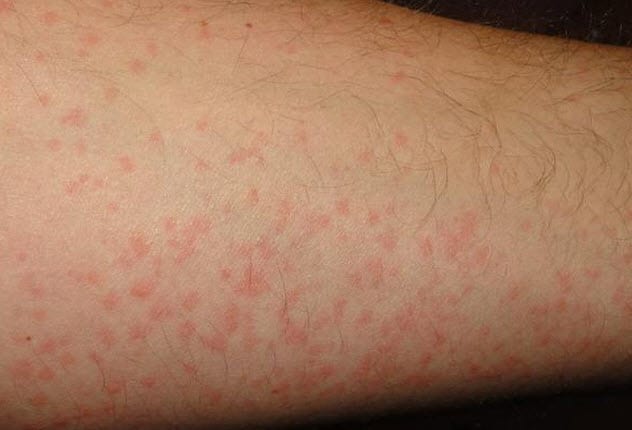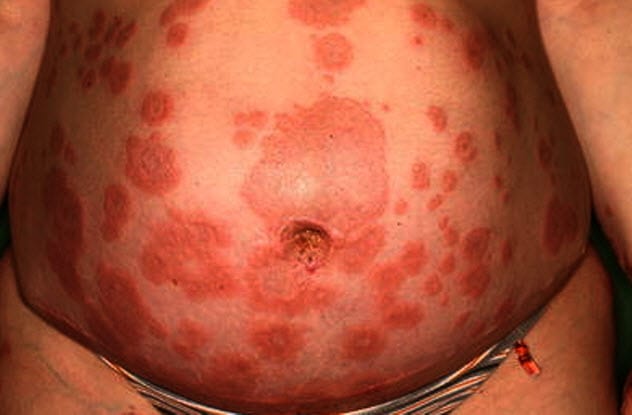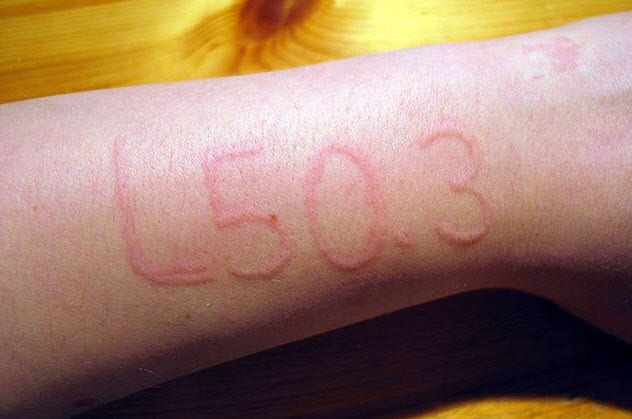But not all allergic reactions are to food or drink. This list will take you through some of the stranger allergies our human bodies can fall victim to.
10 Cold TemperaturesCold Urticaria
Most people don’t particularly like being cold. But for a sufferer of cold urticaria, low temperatures bring on a whole new world of discomfort. Symptoms can range from redness, welts, and itching on skin that has been exposed to the cold all the way to systemic symptoms like headaches, diarrhea, tachycardia, and even anaphylaxis. In most cases, cold urticaria can be diagnosed by a cold stimulation test. (An ice cube in a plastic bag is placed on the arm for five minutes, and the results observed.) If welts appear after a period of 5–10 minutes of rewarming, the test is considered positive. If the ice cube test is negative, cold urticaria cannot necessarily be ruled out. Unfortunately, there are a number of atypical presentations of cold urticaria which are less easily diagnosed. This includes delayed cold urticaria, in which reactions to the cold stimuli may take 3–24 hours to appear, and localized cold urticaria, in which only certain parts of the body will react. Treatment for cold urticaria typically involves the avoidance of cold temperatures. This includes cold foods and beverages, immersion in cold water, and exposure to cold weather. Antihistamines can also be used to alleviate symptoms.[1]
9 PregnancyPemphigoid Gestationis
Pregnancy is a wonderful but sometimes challenging experience for most mothers-to-be. However, for those with pemphigoid gestationis, pregnancy rapidly becomes extremely uncomfortable. Pemphigoid gestationis is an autoimmune condition which occurs predominantly during mid-to-late pregnancy, anywhere from 13 to 42 weeks. It begins with some minor itchy red bumps around the navel. Over the course of days to weeks, these can spread across the body to cover the patient in blisters or welts. The arms, legs, torso, back, and buttocks can be affected, usually leaving the patient’s face, scalp, palms, and soles of the feet unaffected. Unfortunately, pemphigoid gestationis cannot be prevented. Instead, treatment focuses on managing the symptoms. Antihistamines and topical corticosteroid creams can be used to reduce itching. If the case is severe, oral corticosteroids may be prescribed. Usually, symptoms will disappear within weeks after delivery of the baby.[2]
8 VibrationVibratory Urticaria
Vibratory urticaria is a condition in which allergy symptoms such as itching, redness, and swelling are caused by the skin being exposed to vibration, friction, or repeated stretching. If the stimulus is particularly strong, additional symptoms may include fatigue, headaches, metallic taste, blurry vision, or faintness. Simple daily activities like drying off with a towel or taking a bumpy ride in a car can provoke an attack that may last for as long as an hour. Several episodes can occur in one day if the individual is exposed to continued vibratory stimulus. Vibratory urticaria can be caused by a single mutation in the gene which is responsible for making the protein ADGRE2, found in immune cells throughout the body. This mutation causes one amino acid within the protein to be substituted, altering the structure and making it less stable. Vibration and friction are then able to break this protein’s structure, which signals an immune response. This mutation is not responsible for all cases of vibratory urticaria, although it is unknown what other causes may exist.[3]
7 WaterAquagenic Urticaria
People affected by aquagenic urticaria can usually drink water without trouble. However, water coming into contact with their skin causes an allergic reaction. Itching and numerous red welts are the most common symptoms. Shortness of breath occurs less frequently. Thankfully, aquagenic urticaria is an extremely rare allergy, with only around 50 documented cases on record. From the data available, females are more frequently affected than males and symptoms generally begin during puberty or shortly afterward. Although it is not a common condition, aquagenic urticaria is arguably one of the most difficult allergies to live with.[4]
6 SunPhotosensitivity
Photosensitivity is a catchall phrase for a variety of conditions in which an allergic response is caused by sunlight. Sun allergies are most likely to affect the skin in the V of the neck and the outer surfaces of the arms and legs—places which are likely to get a lot of direct sunlight. As more than one condition may be responsible for a sun allergy, symptoms can vary. But they include hives, blisters, itching or burning sensations, and occasionally even bleeding under the skin. These symptoms can occur within minutes of exposure to sunlight or be delayed as long as two days after exposure. What causes sun allergies is not yet known, but scientists have theorized that a hereditary factor could be to blame. The allergy is triggered by a chemical change in skin cells struck by sunlight. The immune system then fails to recognize those cells as belonging to the body and attacks them as if they were foreign invading cells. Unfortunately, people who suffer from a sun allergy may have no choice but to severely limit their time in the sun. They may also work hard to cover up with clothing and sunscreen when they are going to catch some rays.[5]
5 MetalsMetal Hypersensitivity
Many people experience allergic responses when they come into contact with specific metals. Estimates suggest that up to 15 percent of the population could be affected. Symptoms may include pain, swelling, redness, and itching at the site of contact. More seriously, metal hypersensitivity can also present itself as a range of chronic conditions such as fibromyalgia or chronic fatigue syndrome. By far, the metal most responsible for metal sensitivity is nickel—approximately 17 percent of women and 3 percent of men are thought to suffer from this allergy. It is estimated that 1–3 percent of the population is affected by allergic reactions to cobalt and chromium. Likewise, allergic responses have been documented as a result of contact with titanium and copper. These allergic reactions take place when the body begins to identify metal ions as foreign bodies and activates the immune system to defend against the threat. A metal allergy can be highly inconvenient in everyday life. Many cosmetic products contain traces of metals which can set off a reaction. Jewelry, watches, and coins are also known culprits. Older intrauterine devices (IUDs) were manufactured from copper and have previously caused hypersensitivities as have many medical implants such as pacemakers, rods, pins, and plates used to repair injuries. These reactions can be serious because the allergens have been inside the body for a prolonged period of time.[6]
4 SemenHuman Seminal Plasma Hypersensitivity
Yes, this is a serious allergy, not an excuse to avoid intimacy! It is estimated that 40,000 women in the United States are affected by this condition. Men are also able to manifest an allergy to their own semen, but it is unknown how often this happens. Symptoms include redness, soreness, hives, itching, and burning sensations. Women who have a semen allergy may produce antibodies which attack sperm cells and prevent pregnancy. The reaction is caused by an immune response against a specific protein present in the liquid portion of semen. So it does not prevent women from getting pregnant through artificial insemination. Diagnosis of a semen allergy is actually quite simple. If a condom is used and the symptoms stop, the cause of the reaction has effectively been identified. Treatments include a series of shots with increasing concentrations of seminal fluids to desensitize the person experiencing the reaction. Alternatively, for those who dislike needles, condoms will effectively prevent symptoms.[7]
3 Plastics
Allergic reactions to plastics are not common but certainly not unheard of. They come under the subheading of contact urticaria, or allergic reactions from contact. Several chemicals present or used in the production of plastics can be to blame, including polyethylene, polyvinyl chloride (PVC), butylhydroxytoluene (BHT), and diisodecyl phthalate (DIDP).[8] Symptoms of an allergic reaction to plastic are redness, itching, and swelling at the location of contact. Treatments include topical steroids and antihistamines.
2 Wood
Given the hundreds of different species of trees in the world, wood seems like a strange allergy. However, this type of allergy seems to be no secret among woodworkers across the world. Many databases are dedicated to listing species, possible reactions, areas of the body affected, and the potency of the possible reaction. Reactions to various species include skin irritations, sneezing, nosebleeds, vomiting, and even nasopharyngeal cancer. Most at risk are people who are working with wood or in situations where sawdust may be inhaled (as particles may enter the body through the airways). Of course, just because one species of wood has been known to cause symptoms in the past does not mean that everyone will suffer the same reaction. Likewise, having an allergic response to one species of wood does not mean that an individual is at risk of a reaction to wood from all tree species.[9]
1 TouchDermatographic Urticaria
Dermatographic urticaria (aka dermographism) is an allergic response to the touching of the skin. Dermographism means “writing on the skin,” as only a firm stroke is needed to elicit redness and then wheals on the skin of individuals with this allergy. Some people with this condition experience itching in addition to the redness and welts on their skin. The exact mechanisms which cause dermographism are still unknown, although the immune system is obviously involved. It is most common in young adults and does not affect any gender or race at greater frequencies. However, women who are pregnant or beginning menopause are known to have an increased incidence of this allergy. Fortunately, most patients with dermographism are otherwise quite healthy. For many patients, symptoms decrease over time and may eventually disappear. Until then, antihistamines can be used to help control symptoms.[10]























